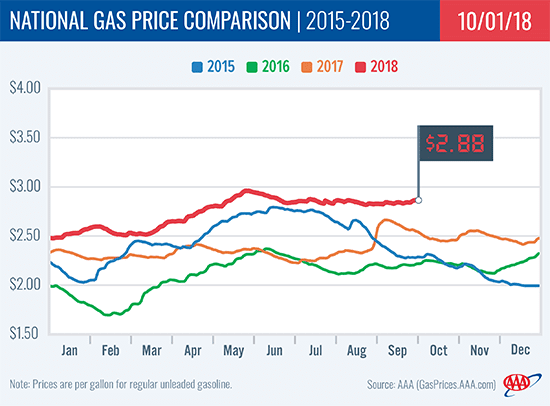Gem State prices continue to drop despite the rising national average
BOISE – (October 2, 2018) – Chilly Fall weather and school obligations are keeping more drivers and families close to home, with gasoline demand dropping as a result. But concerns about the global oil supply are putting upward pressure on crude prices, causing a ripple effect at the pump. The U.S. average gas price has increased three cents in the last week, and five cents in the last month.
“In Idaho, however, there’s been better news – Gem State prices have dropped by a dime over the past month, in the typical pattern that we see with reduced demand and the return of cheaper-to-produce winter-blend fuel,” says AAA Idaho spokesman Matthew Conde. “It’s not great to be the 7th highest in the country for gas prices, but it certainly beats being in 5th place a short time ago.”
National gasoline demand has dropped to nine million barrels per day, and inventories have grown to 235.7 million barrels, according to the Energy Information Administration. Even so, the national gas price today is $2.88, which is five cents more than a month ago and 33 cents more than a year ago. The current U.S. average is the highest since mid-July, and the most expensive start of October since 2014.

Idaho drivers are faring somewhat better in recent weeks – today’s average gas price is $3.15, which is ten cents less than a month ago and 39 cents more than a year ago. Just a month ago, Gem State prices were 40 cents higher than the national average, but the margin has narrowed to 27 cents today.
“Idaho gas prices, and the Rocky Mountain region in general, are among the last to react to a national change,” Conde said. “Hopefully local prices will continue to ignore national and international market forces for a while longer.”
Oil market dynamics
Venezuela’s continued economic collapse and concerns surrounding the impact of U.S.-imposed sanctions on Iran that will take effect later this fall have sent shockwaves across the global oil market. Since mid-September, the West Texas Intermediate (WTI) crude oil index has jumped by more than six dollars a barrel.
Today, a barrel of crude oil is trading near $75, which is five dollars more than a month ago and a whopping 25 dollars more than a year ago.
“So far, OPEC’s agreement to lift most of the production cuts that were initiated in 2017 hasn’t helped the market change course,” Conde said.
Domestic crude oil inventories are now roughly 75 million bbl lower than they were at this time last year. The current oil rig count is 863, and there are 113 more rigs now than in 2017.
“The average American family has paid somewhere around $250 more to meet their fuel needs this year,” Conde said. “If the international oil supply remains tight, or if the market is fearful that it will be, higher gas prices could make holiday travel a more expensive proposition this year.”
AAA and other interested parties will continue to keep an eye on market activity and keep the public informed.
Here’s a quick look at gas prices around the Gem State: Aberdeen, $3.15; Ammon, $3.06; Basalt, $2.92; Blackfoot, $3.12; Bliss, $3.19; Boise, $3.15; Bonners Ferry, $3.17; Burley, $3.25; Cascade, $3.20; Coeur d’Alene, $3.08; Council, $3.29; Donnelly, $3.34; Downey, $3.15; Eden, $3.28; Emmett, $3.16; Franklin, $3.13; Fruitland, $3.21; Glenns Ferry, $3.14; Gooding, $3.10; Hailey, $3.21; Hayden Lake, $3.07; Horseshoe Bend, $3.20; Idaho Falls, $3.08; Island Park, $3.50; Kellogg, $3.26; Ketchum, $3.35; Kooskia, $3.16; Kuna, $3.02; Lava Hot Springs, $3.15; Lewiston, $3.20; Marsing, $3.16; Moscow, $3.27; New Plymouth, $3.04; Orofino, $3.16; Parma, $3.16; Pocatello, $3.15; Post Falls, $3.09; Rigby, $3.02; Soda Springs, $3.19; Stanley, $3.40; Sugar City, $3.19; Twin Falls, $3.14; Wallace, $3.26; Weiser, $3.17.

